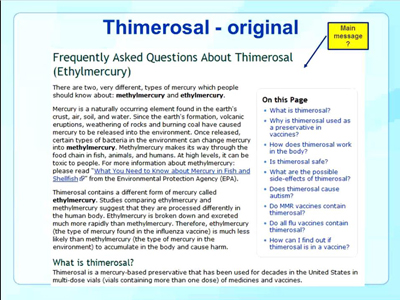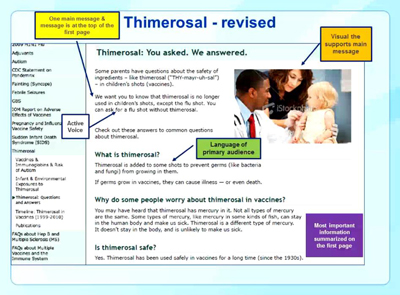Health literacy is defined as “the degree to which individuals have the capacity to obtain, process, and understand basic health information and services needed to make appropriate health decisions.” Do you and your researchers do your part to improve communication practices to optimize participant comprehension?
Recently, PRIM&R hosted a webinar titled Health Literacy: Fostering Comprehension in Research and Clinical Care, presented by Cynthia Baur, PhD, senior advisor for health literacy and the senior official for the Plain Writing Act, Office of the Associate Director for Communication, Centers for Disease Control and Prevention (CDC), US Department of Health and Human Services (HHS); Laurie Myers, MBA, health literacy strategy at Merck & Co, Inc., and co-lead of the Multi-Regional Clinical Trials Center at Harvard Return of Results Group; and Walter H. Straus, MD, MPH, Associate Vice President, Clinical Safety and Risk Management 2 at Merck Research Laboratories, Merck & Co, Inc., and member of PRIM&R’s Board of Directors. Why is health literacy so crucial and what are the consequences when we do not prioritize it in research and clinical care? Dr. Straus opened by emphasizing the importance of clear communication. Distinct from the high-level regulatory and compliance topics many of us work with on a daily basis, the need for clear communication is more important in the direct interaction a patient or participant has with a researcher, clinician, or with written study or treatment materials. When participants and patients experience clear and concise communication with researchers and clinicians they are more likely to understand the study or treatment’s purpose, which leads to better results. The consequences of poor communication include inadequate patient care and compromised study results; it also hinders subjects’ ability to participate fully in research.
Who experiences the negative effects of low health literacy and unclear communication? Ms. Myers explained that certain populations, such as low-income, elderly, non-English speakers, and minorities are at risk for low health literacy. The consequences of low health literacy include less use of preventative care and screenings, less knowledge of chronic conditions and their optimal management, more hospital admissions for potentially preventable causes, more emergency department visits, and less understanding of medication. Our healthcare system is complex, and even individuals with high health literacy struggle to understand healthcare instructions and materials. For this reason, Ms. Myers recommended communicating clearly and simply across-the-board in all of our interactions and materials.
Both researchers and clinicians can agree they support clear communication, but how do we modify our everyday practices to reflect the principles of health literacy? The presenters taught us how to apply the concepts of health literacy both in one-on-one communication and in written materials. Ms. Myers highlighted the “teach-back” method as a means to ensure a participant understands key information. When participants are able to repeat back the instructions they’ve received before leaving the site, it means they understand the crucial information. Ms. Myers also encouraged attendees to be aware of a patient’s numeracy (ability to use basic probability and mathematical concepts to explain mathematical and statistical terms) in communication and in written materials. By avoiding complex fractions, percentages, and statistical terms, and by using numbers only when they are relevant and necessary, their use will be more likely to drive home important messages. Cultural literacy (ability to understand and participate in a given culture) on the part of the researcher and/or clinician is also important in encouraging research participation and in communicating results.
The presentation shifted to practical application of health literacy principles in written material. Dr. Baur shared the CDC’s Clear Communication Index (Index), which is a free tool that helps researchers and clinicians develop and assess public communication materials. The Index has four open-ended introductory questions and 20 scored items, which represent the most important characteristics that enhance and aid people’s understanding of the information presented. It assesses materials in these seven areas:
- Main message and call to action
- Language
- Information design
- State of the science
- Behavioral recommendations
- Numbers
- Risk
The Index promotes clarity when writing new materials and revising old ones by scoring the readability of material. If the score is 89/100 or less, one can identify the sections which scored 0 points and re-write them based on the descriptions and examples in the Index’s user guide. The Index can be used as many times as one needs to achieve an adequate score. Dr. Baur shared examples of materials before and after they were run through the Index. In one example, attendees saw a website feature about the presence of Thimerosal in vaccines. The original piece was text-heavy and its objective w
After being run through the Index and revised, the piece had a clear main message at the top of the page; utilized more active voice, calls to action, and lay language; and contained imagery that supported the main message.

This example, along with the others provided, illustrated the Index’s usefulness toward the goals of readability, clarity, and conciseness in written materials.
The webinar closed with a robust question and answer session, which included discussion of how to apply these principles to informed consent documents, how to communicate with and demonstrate to investigators that clear communication improves research results, how to communicate with multiple parties around informed consent, and the future of health literacy in research and clinical care.
Please visit the following resources to find out more about how you can apply the principles of health literacy at your own institution:
- CDC Clear Communication Index
- Health Literacy Interventions and Outcomes: An Updated Systematic Review, by the Agency for Healthcare Research and Quality
- Institute of Medicine’s (IOM) Roundtable on Health Literacy: Workshop Summary
The recording of this webinar is available to PRIM&R members in the Knowledge Center. Nonmembers can purchase the archive here.
PRIM&R would like to thank Dr. Baur, Ms. Myers, and Dr. Straus for sharing their expertise. Do you have an idea for a webinar? Consider contributing to our third annual Call for Webinar Proposals.

One THOUGHTS ON “Webinar Follow-Up: Health Literacy – Fostering Comprehension in Research and Clinical Care”